Dietary essential amino acids restore liver metabolism in ovariectomized mice via hepatic estrogen receptor α
- PMID: 34824281
- PMCID: PMC8617046
- DOI: 10.1038/s41467-021-27272-x
Dietary essential amino acids restore liver metabolism in ovariectomized mice via hepatic estrogen receptor α
Abstract
In female mammals, the cessation of ovarian functions is associated with significant metabolic alterations, weight gain, and increased susceptibility to a number of pathologies associated with ageing. The molecular mechanisms triggering these systemic events are unknown because most tissues are responsive to lowered circulating sex steroids. As it has been demonstrated that isoform alpha of the estrogen receptor (ERα) may be activated by both estrogens and amino acids, we test the metabolic effects of a diet enriched in specific amino acids in ovariectomized (OVX) mice. This diet is able to block the OVX-induced weight gain and fat deposition in the liver. The use of liver-specific ERα KO mice demonstrates that the hepatic ERα, through the control of liver lipid metabolism, has a key role in the systemic response to OVX. The study suggests that the liver ERα might be a valuable target for dietary treatments for the post-menopause.
© 2021. The Author(s).
Conflict of interest statement
The authors declare no competing interests.
Figures
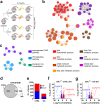
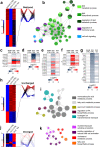
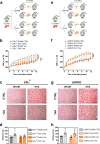
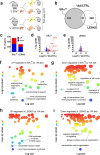
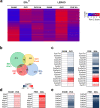
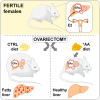
Similar articles
-
Xiaoyao San attenuates hepatic steatosis through estrogen receptor α pathway in ovariectomized ApoE-/- mice.J Ethnopharmacol. 2022 Jan 10;282:114612. doi: 10.1016/j.jep.2021.114612. Epub 2021 Sep 5. J Ethnopharmacol. 2022. PMID: 34496266
-
Estrogen receptor alpha activation enhances mitochondrial function and systemic metabolism in high-fat-fed ovariectomized mice.Physiol Rep. 2016 Sep;4(17):e12913. doi: 10.14814/phy2.12913. Physiol Rep. 2016. PMID: 27582063 Free PMC article.
-
Hepatic ERα accounts for sex differences in the ability to cope with an excess of dietary lipids.Mol Metab. 2020 Feb;32:97-108. doi: 10.1016/j.molmet.2019.12.009. Epub 2019 Dec 24. Mol Metab. 2020. PMID: 32029233 Free PMC article.
-
Role of Estrogens in the Regulation of Liver Lipid Metabolism.Adv Exp Med Biol. 2017;1043:227-256. doi: 10.1007/978-3-319-70178-3_12. Adv Exp Med Biol. 2017. PMID: 29224098 Free PMC article. Review.
-
Sexual Dimorphism and Estrogen Action in Mouse Liver.Adv Exp Med Biol. 2017;1043:141-151. doi: 10.1007/978-3-319-70178-3_8. Adv Exp Med Biol. 2017. PMID: 29224094 Review.
Cited by
-
Interaction between estrogen receptor-α and PNPLA3 p.I148M variant drives fatty liver disease susceptibility in women.Nat Med. 2023 Oct;29(10):2643-2655. doi: 10.1038/s41591-023-02553-8. Epub 2023 Sep 25. Nat Med. 2023. PMID: 37749332 Free PMC article.
-
Diet and Fertility Status: Relevance in Health and Disease.Nutrients. 2023 Mar 29;15(7):1669. doi: 10.3390/nu15071669. Nutrients. 2023. PMID: 37049511 Free PMC article.
-
Metabolic dysfunction-associated steatotic liver disease across women's reproductive lifespan and issues.Clin Mol Hepatol. 2025 Jan;31(1):327-332. doi: 10.3350/cmh.2024.0419. Epub 2024 Aug 5. Clin Mol Hepatol. 2025. PMID: 39098816 Free PMC article. No abstract available.
-
Sex-specific effects of PNPLA3 I148M.Liver Int. 2025 Mar;45(3):e16088. doi: 10.1111/liv.16088. Epub 2024 Sep 11. Liver Int. 2025. PMID: 39262132 Free PMC article. Review.
-
Sex and Liver Disease: The Necessity of an Overarching Theory to Explain the Effect of Sex on Nonreproductive Functions.Endocrinology. 2022 Jan 1;163(1):bqab229. doi: 10.1210/endocr/bqab229. Endocrinology. 2022. PMID: 34758075 Free PMC article. Review.
References
-
- Della Torre S, Benedusi V, Fontana R, Maggi A. Energy metabolism and fertility: a balance preserved for female health. Nat. Rev. Endocrinol. 2014;10:13–23. - PubMed
-
- Della Torre S, Maggi A. sex differences: a resultant of an evolutionary pressure? Cell Metab. 2017;25:499–505. - PubMed
-
- Roy AK, Chatterjee B. Sexual dimorphism in the liver. Annu. Rev. Physiol. 1983;45:37–50. - PubMed

